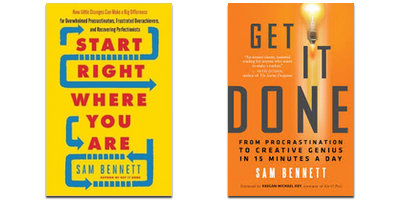
You have an idea that seems interesting. You might even be tempted to take action on it. But then you immediately start to reconsider. Is it actually a good idea, or just an average idea, or worst of all, a terrible idea? You begin to imagine the outcomes of acting on this idea, and all the permutations of all the outcomes. You start to envision the disappointment of having made a poor decision, and suddenly it seems much better to not do anything at all.
This is how great ideas die.
This is how Highly Creative People stay stuck.
One of the characteristics of the Highly Creative Person is a real gift for nuance and subtlety. If you are an HCP, you love intricacy, multiplicity and process, and are somewhat more likely than most to use the word “liminal” in conversation.
You read micro-expressions.
You consider your words carefully.
You notice connections between things before others have noticed anything at all.
Here’s the problem: you overcomplicate every.damn.thing.
You may have noticed yourself overthinking yourself into inaction.
You may have discovered that you overwork for no reason or reward.
You may be habitually overwrought.
And all this “over-” is exhausting for you and for the people around you.
On the other hand, you don’t want to dumb yourself down.
So what’s a twisty little brainiac like you to do?
TRY THIS: First thought, best thought.
Why this works: your processing speed is a bit faster than everyone else’s, so the thought that feels like it just popped into your consciousness has actually undergone a fairly elaborate, if invisible, process of evolution. You may not know how you know – but you know. You process information, intuition and patterns quickly, and then you are able to make connections between disparate bits of information with supersonic speed. You can trust that your body and brain have, in fact, “thought” about it for you, and have delivered a sound outcome.
If nothing else, moving forward from your first thought puts you into experimentation mode, which will lead you to new thoughts and new outcomes. Which is waaaaay better than just sitting there spinning your wheels, yes?
TRY THIS: Put it in Beta
Rather than think of every idea as a full commitment or a final decision, think of yourself as putting your ideas into beta testing. (Beta testing is the stage of software development when the creators think they’ve got something that might work, and even though it’s not near done yet, they invite users to start testing and giving feedback. So the users know they are mucking around with something that’s not complete, and enjoy the process of poking holes, finding bugs and discovering weaknesses that the designers may never have even considered.)
Beta-testing your ideas allows you to experiment with the deliberately imperfect.
To put your ideas into beta, think of the smallest, easiest component that you can put into action the quickest.
Have an idea for a class? Why not invite 3 people to coffee to talk it over?
Have an idea for a book? Go ahead and start by writing a few sentences on one index card every day for a week.
Have an idea for a new business or marketing scheme? Why not put up a teaser post on social media to gauge initial reactions?
TRY THIS: Ask someone you adore.
We all have a few smart friends whose opinion we take seriously. Why not cash in some of those Friendship Points and ask them for five minutes of their time. You can’t do this non-stop, of course, but it’s amazing how having to explain your idea to someone you respect can clarify your thinking, and how much insight a smart person can bring in just a few minutes. Be sure to offer to return the favor, of course.
TRY THIS: Google it.
I am astonished by the number of people who confide an idea to me when they haven’t spent even five minutes looking into it. Do yourself a favor and Google your idea to do a quick check on whether it’s been done before, and by whom. This is what is known as research, and it is an important part of the development of an idea.
Just because something’s been done before is no reason not to do it – quite the contrary. If someone has already proved the market for an idea, that’s excellent news. Mostly you want to know if an idea has been tried so you can learn from their mistakes and figure out how your idea is better, different, cheaper, or more interesting.
TRY THIS: Try it.
Spend 15 minutes every day for a week (a month, a year) noodling around on your idea. Let it see sunlight. See if it goes anywhere. See if you wake up thinking about it (usually a good sign) or if you don’t want to stop working on it (always a good sign). It’s fine if you play with an idea for a while and then decide it’s not worthwhile, or not the right time. At least you’ll have gotten your hands dirty and learned something.
You have some amazing ideas to offer the world – but you’ve got to stop torturing them inside of your mind and start letting them see the light of day, yes?
Want to know more about the Highly Creative Person? Take this quiz here and let me know what you think.
#theworldneedsyourideas


Great suggestions, thanks Sam!